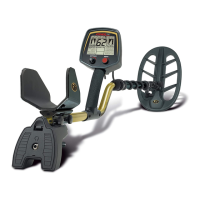SEARCH TECHNIQUES (continued)
NUISANCE BURIED OBJECTS
In some areas there is a lot of metallic trash which produces weak signals. These could
include deeply buried objects, little bits and pieces of rusty iron and corroded foil. These
items can be detected, but are difficult to pinpoint due to their depth and small size. When
you dig and find nothing, it may seem like the machine is beeping at nothing even though
there is actually something there. The best solution is usually to reduce sensitivity.
If searching a very trashy area and unwanted signals are a problem, search with the
searchcoil 2 inches away from the ground. Trash objects very close to the searchcoil will
sometimes not be completely eliminated, even when the discrimination setting should have
eliminated the target.
Metal detectors are designed to see one metal object at a time. Where there are two iron
objects near each other, the detector can be fooled into thinking that the gap between them
is nonferrous metal. This is a common condition where a wooden building has burned or
been torn down, and the site is littered with nails. A signal from a nonferrous metal object
such as a coin will usually be repeatable, whereas a false positive signal resulting from
multiple or oddly shaped iron objects will seem to wander around and even to vanish.
Experienced detectorists call these non-repeating signals and usually do not bother digging
them since nonrepeating signals are almost always trash.
GROUND MINERALS
Conductive mineral salts usually produce broad signals which will not be mistaken for a
metallic object. Common causes are concentrations of mineral fertilizer, spots where
evaporation has concentrated naturally occurring mineral salts, residue from de-icing salts,
and urine from livestock. Unless dry, “cow pies” can sound off like they are metal. Ocean
beaches have salt water—that subject is discussed elsewhere in the manual.
In spots where there has been intense fire, such as a campfire site or where a stump was
burned during land clearing, the soil minerals may be altered by oxidation so that their
ground balance setting is lower than that of the surrounding soil. In such cases, search
slowly and change the G.B. setting as frequently as necessary.
In some areas, electrically conductive industrial minerals such as fuel coke, slag, clinkers
(left over from burning mineral fuels), or charcoal have been dumped or used as landfill.
Individual lumps of these materials can usually be quieted by reducing sensitivity and
searching with a discrimination level of at least 25. However, where the ground consists
primarily of such materials, you may not be able to search quietly. In that case, do not dig
unless a signal is crisp and repeatable.
Electrically conductive natural minerals such as graphite, graphitic slate, or sulfide ore
minerals are rarely encountered except when gold prospecting. When gold prospecting,
you need to be able to hear everything, and you can expect to dig conductive minerals that
turn out not to be gold. In a given locality you may learn to recognize what type of rocks
these minerals are found in, and to ignore them if people in the area say that gold is not
found in rocks of that type.

